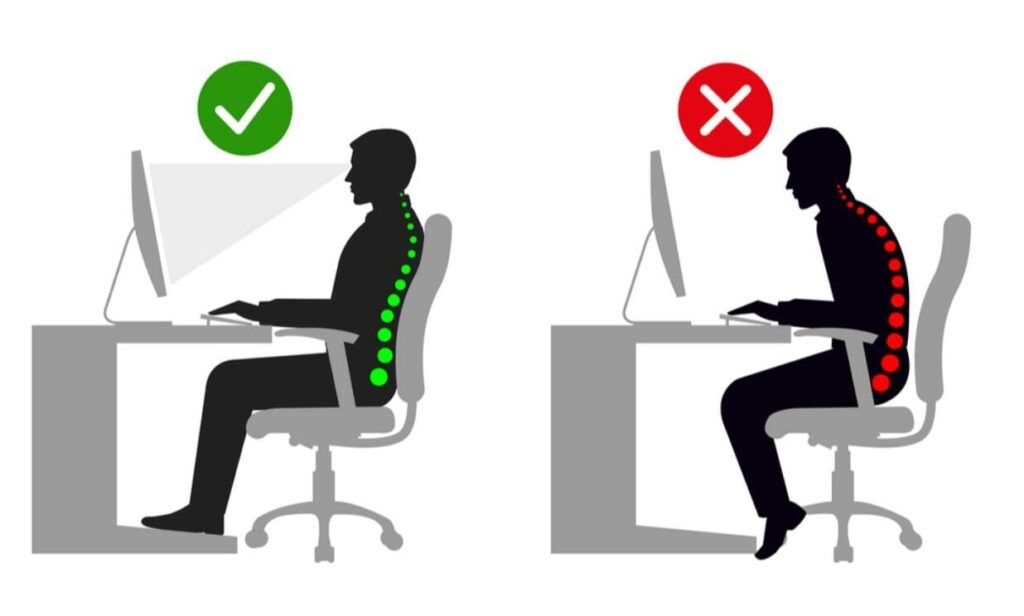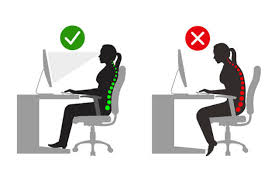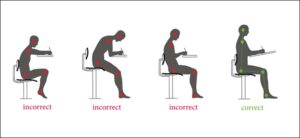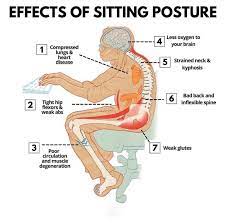

Sitting posture plays a crucial role in maintaining proper head alignment and overall musculoskeletal health.
As per BestForwardHeadPostureFix.Com, “Poor posture while sitting can lead to forward head posture (FHP), which places excessive strain on the cervical spine and surrounding muscles”.
As per a study published in the European Spine Journal (2023), forward head posture is directly linked to increased stress on the cervical vertebrae, leading to muscle fatigue, neck pain, and long-term spinal issues.
Understanding the influence of sitting posture on head alignment is essential for preventing health complications and improving well-being.
Article Index
- The Connection Between Sitting Posture and Head Alignment
- Common Postural Deviations Affecting Head Position
- Health Consequences of Poor Head Alignment
- Ergonomic Strategies to Maintain Proper Head Alignment
- Exercises to Improve Sitting Posture and Head Position
- 10 Hidden Facts on Your Sitting Posture & Head Alignment
- The Role of Technology in Monitoring Posture
- FAQS on Sitting Posture and Nerd Neck
- Expert Recommendations for Optimal Sitting Posture
- Conclusion
The Connection Between Sitting Posture and Head Alignment
The human body is designed for movement, but prolonged sitting—especially with poor posture—disrupts the natural alignment of the spine and head.
As per research in the Journal of Orthopaedic & Sports Physical Therapy (2022), maintaining a neutral spine while sitting ensures that the head remains directly above the shoulders, minimizing strain.
However, poor sitting habits, such as slouching or craning the neck forward while using electronic devices, lead to an altered head position, increasing the load on cervical structures.
Studies show that for every inch the head moves forward, an additional 10 pounds of pressure is exerted on the neck muscles (Spine Journal, 2023).
Over time, this strain can cause structural changes in the cervical spine and result in musculoskeletal disorders.
Common Postural Deviations Affecting Head Position
Several sitting postures contribute to poor head alignment, including:
- Slouched Shoulders: Rounding the shoulders forward causes the head to protrude, disrupting its natural alignment. A study in Ergonomics Journal (2022) reported that individuals with rounded shoulders are more prone to developing FHP.
- Leaning Forward: Sitting too close to screens can shift the head forward, straining the neck and upper back muscles.
- Pelvic Tilt: Improper lumbar support can lead to anterior or posterior pelvic tilt, indirectly affecting head posture.
Correcting these deviations requires conscious effort and ergonomic adjustments to ensure the spine and head remain in a neutral position.
Health Consequences of Poor Head Alignment
Improper head alignment due to poor sitting posture has several significant health consequences that can impact daily life and long-term well-being.
As per Mayo Clinic Proceedings (2023), prolonged forward head posture (FHP) places excessive strain on the cervical spine, leading to musculoskeletal and systemic complications.
- Neck and Shoulder Pain: Chronic misalignment causes muscle imbalances, contributing to persistent tension and discomfort in the cervical and shoulder regions. Over time, this strain can lead to reduced range of motion and muscle fatigue.
- Headaches: Increased strain on the neck muscles can lead to tension-type headaches and even migraines due to compromised blood flow and nerve compression.
- Spinal Degeneration: Persistent forward head posture accelerates wear and tear on intervertebral discs, increasing the risk of conditions such as cervical spondylosis and herniated discs.
- Reduced Lung Function: According to the Journal of Physical Therapy Science (2022), slouching compresses the thoracic cavity, limiting lung expansion and decreasing respiratory efficiency, which can reduce oxygen intake.
Early intervention through ergonomic corrections and targeted exercises can prevent these complications and improve overall spinal health.
Ergonomic Strategies to Maintain Proper Head Alignment
Implementing ergonomic strategies can help maintain head alignment while sitting. Key recommendations include:
- Chair Selection: Use a chair with lumbar support to maintain spinal curvature and prevent slouching.
- Screen Height: Position monitors at eye level to avoid tilting the head forward, as recommended by the Occupational Safety and Health Administration (OSHA).
- Foot Positioning: Keeping feet flat on the floor helps stabilize the pelvis and maintain a neutral head position.
- Posture Breaks: A study in Applied Ergonomics (2023) suggests taking short breaks every 30 minutes to reset posture and prevent muscular fatigue.
These adjustments can significantly reduce the negative impact of poor sitting posture on head alignment.
Exercises to Improve Sitting Posture and Head Position
Specific exercises play a crucial role in strengthening the muscles that support proper head alignment and preventing the negative effects of forward head posture (FHP).
As per a study in the Journal of Strength and Conditioning Research (2022), targeted exercises can help restore proper posture and reduce musculoskeletal strain.
- Chin Tucks: This simple yet effective exercise involves pulling the chin backward to align it with the spine. Chin tucks strengthens the deep cervical flexor muscles and counteracts FHP caused by prolonged screen use.
- Shoulder Blade Retractions: Strengthening the upper back muscles, particularly the rhomboids and trapezius, helps to pull the shoulders back and maintain an upright posture.
- Neck Stretches: Gentle stretches targeting the neck and upper trapezius muscles improve flexibility, relieve tension, and enhance the range of motion.
Consistently practicing these exercises improves muscle endurance, enhances postural awareness, and reduces discomfort associated with prolonged poor posture. Integrating them into a daily routine can significantly improve head and neck alignment over time.
10 Hidden Facts About Your Sitting Posture and Head Alignment No One Wants You to Know
Your Forward Head Posture Adds 10 Pounds of Pressure for Every Inch Forward
According to research published in Surgical Technology International, for every inch your head juts forward, your neck experiences an extra 10 pounds of pressure. This can lead to chronic pain, headaches, and spinal misalignment.Sitting Slouched Can Shrink Your Lungs
Poor posture reduces lung capacity by up to 30%, as shown in studies from the Archives of Internal Medicine. Slouching compresses the diaphragm, making it harder for you to breathe deeply.Bad Sitting Posture Can Cause Brain Fog
Limited oxygen intake from shallow breathing impacts brain function. You may feel tired or mentally sluggish simply because of your forward head posture.Your Spine is Designed for Movement, Not Sitting
Sitting for prolonged periods stiffens the spine, reducing its natural range of motion. Research from Spine Health Journal suggests that even short periods of movement throughout the day help maintain spinal flexibility.Forward Head Posture Can Age Your Spine Faster
Studies show that misalignment in the cervical spine accelerates wear and tear, leading to degenerative disc disease.Crossing Your Legs May Be Bad for Your Back
It might feel comfortable, but sitting with crossed legs tilts your pelvis, throwing off spinal alignment and increasing back pain risk.Poor Posture Can Cause Digestive Issues
Slumping after meals compresses abdominal organs, contributing to acid reflux and bloating.Your Core Strength Directly Impacts Posture
A weak core means your back and neck compensate, leading to tension and pain.Posture Affects Your Mood
Research in Health Psychology shows that upright posture reduces stress and boosts self-esteem.Good Posture Can Make You Look Taller and More Confident
An aligned spine improves your appearance, instantly making you look more poised and energetic!
The Role of Technology in Monitoring Posture
Technological advancements have revolutionized the way we monitor and correct posture, offering convenient solutions to prevent forward head posture (FHP) and related musculoskeletal issues.
As per Digital Health Journal (2023), modern posture-tracking devices and applications provide real-time feedback, helping users maintain proper head alignment and spinal posture by alerting them to slouching or excessive forward head tilt.
Common posture-monitoring solutions include:
- Wearable Posture Trackers: Small, lightweight devices worn on the upper back that gently vibrate to remind users when their posture deviates from the optimal position.
- Mobile Applications: Using smartphone cameras and motion sensors, these apps analyze posture and provide personalized corrective suggestions, making posture improvement accessible anywhere.
- Smart Desks and Chairs: Advanced ergonomic furniture equipped with sensors to detect postural shifts and promote active sitting by encouraging micro-adjustments.
These technological tools are valuable aids for individuals who spend long hours sitting, helping them adopt better habits and prevent chronic neck and back strain.
FAQS on Sitting Posture and Nerd Neck
1) What’s the biomechanical link between slouching and a “forward head”?
When you slump, the mid-back rounds (more thoracic kyphosis) and the shoulders drift forward. To keep eyes level with the screen, the head translates anteriorly—classic forward head posture (FHP). This increases cervical extensor load, shortens suboccipitals, lengthens deep neck flexors, and raises compressive forces at the lower cervical spine.
2) Does pelvic position or chair angle really change where my head ends up?
Yes. A posterior pelvic tilt (tail tucked) flattens lumbar lordosis and nudges the entire spine toward flexion; the neck follows with chin-forward drift.
Restore a slight anterior tilt with lumbar support, seat-pan tilt of about 5–10°, and feet grounded—your ribcage stacks over the pelvis and the head naturally centers over the shoulders.
3) What monitor height and distance reduce forward head?
Keep the screen roughly at arm’s length (about 40–75 cm). Place the top of the display near or slightly below eye level so the gaze lands in the upper third without craning.
If you wear progressive lenses, drop the monitor a bit more to avoid chin-jutting. Center the screen—off-axis viewing invites head protrusion.
4) Will a standing desk actually improve head alignment, or is that hype?
It can help when paired with posture cues. Standing (or sit-stand cycling) encourages a neutral pelvis and reduces prolonged flexion.
Studies in office workers show measurable improvements in craniovertebral angle (a key FHP metric), reduced neck discomfort, and less muscle fatigue when sit-stand setups and coaching are combined.
5) How do I spot posture-related head misalignment—and why fix it?
Side-view check: ear over shoulder. If the ear sits forward, you are in FHP. Beyond neck aches and tension headaches, FHP can alter sensorimotor control and balance—another reason to correct it for comfort and stability.
Field-tested tips from ergonomics communities:
Bring the monitor to you (don’t chase it with your chin), keep elbows near the body, set hip angle ~100–110°, use a small lumbar bolster, schedule micro-breaks (30–60 seconds each hour), and pair sitting tweaks with deep-neck-flexor training and mid-back mobility.
Expert Recommendations for Optimal Sitting Posture
Healthcare professionals emphasize the importance of maintaining proper sitting posture to prevent forward head posture (FHP) and associated musculoskeletal issues.
Adopting best practices can significantly reduce strain on the neck and spine, improving overall well-being.
- Maintain a Neutral Spine: Ensuring that the ears align with the shoulders helps to distribute weight evenly and minimize undue stress on the cervical spine. Poor alignment can lead to chronic neck pain and muscle imbalances.
- Engage Core Muscles: Activating the core provides essential support for the spine, preventing slouching and maintaining stability during prolonged sitting periods. Strong core muscles reduce the likelihood of postural collapse.
- Adjust Workstations: Setting up ergonomic desks, chairs, and monitor heights at eye level promotes better posture. According to Human Factors (2023), an ergonomically optimized workstation and correct keyboard encourages proper spinal alignment and reduces the risk of posture-related disorders.
Consistent adherence to these practices can prevent the negative impacts of poor posture, such as neck strain, tension headaches, and long-term spinal disc degeneration.
Healthcare professionals recommend regular self-checks and incorporating movement breaks to sustain healthy posture habits throughout the day.
Takeaway
Your sitting posture plays a bigger role in head alignment than you might think.
Slouching while watching TV or hunching over your desk can put extra strain on your neck and spine, leading to discomfort and long-term health issues.
Research shows that maintaining proper head alignment with simple ergonomic strategies—like adjusting your chair height, keeping your screen at eye level, and taking regular movement breaks—can help prevent problems like forward head posture and chronic neck pain.
By paying attention to how you sit and making small adjustments, you can significantly improve your musculoskeletal health and overall well-being.
Adding targeted exercises, like neck stretches and cervical retraction exercises, can strengthen muscles that support good posture.
As The Journal of Physical Therapy Science (2023) points out, consistency is key in preventing posture-related problems. Taking a proactive approach to posture management will help you stay comfortable and healthy, even in today’s screen-heavy lifestyle.
References:




